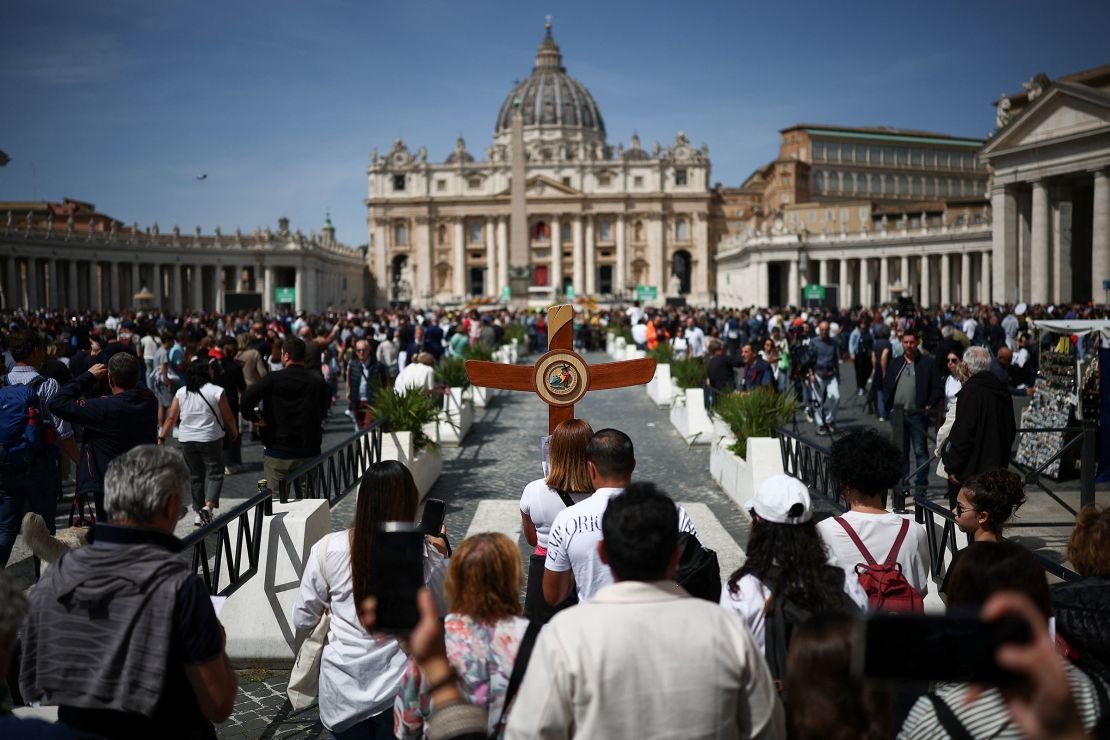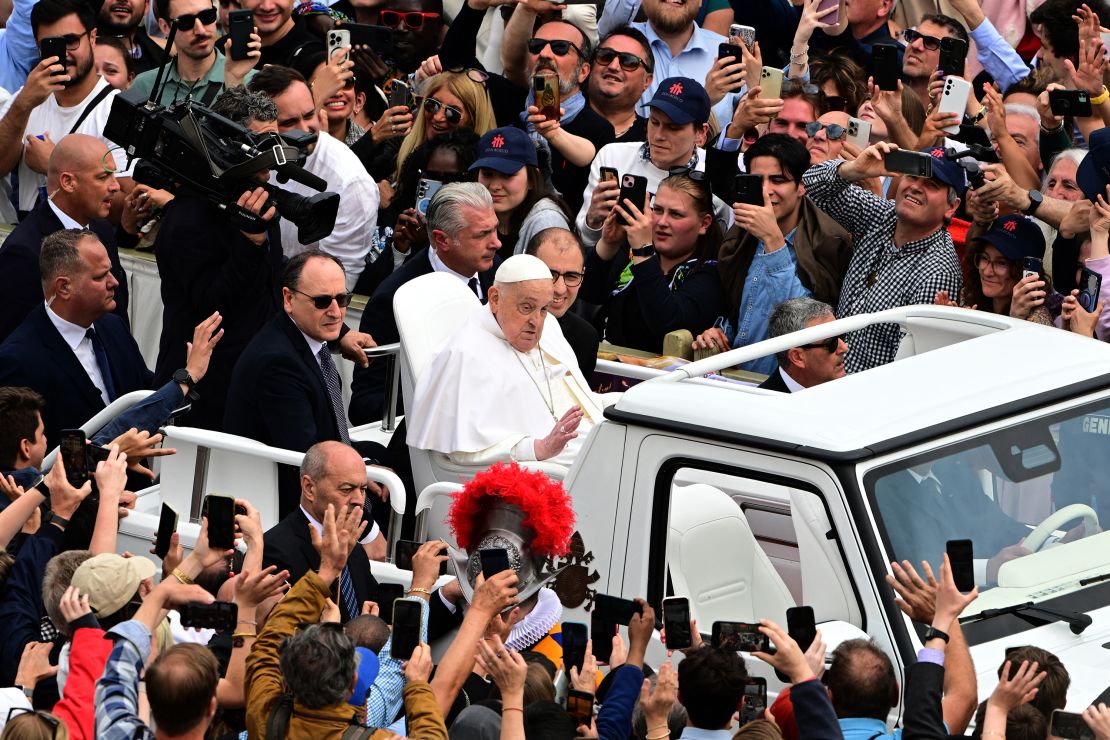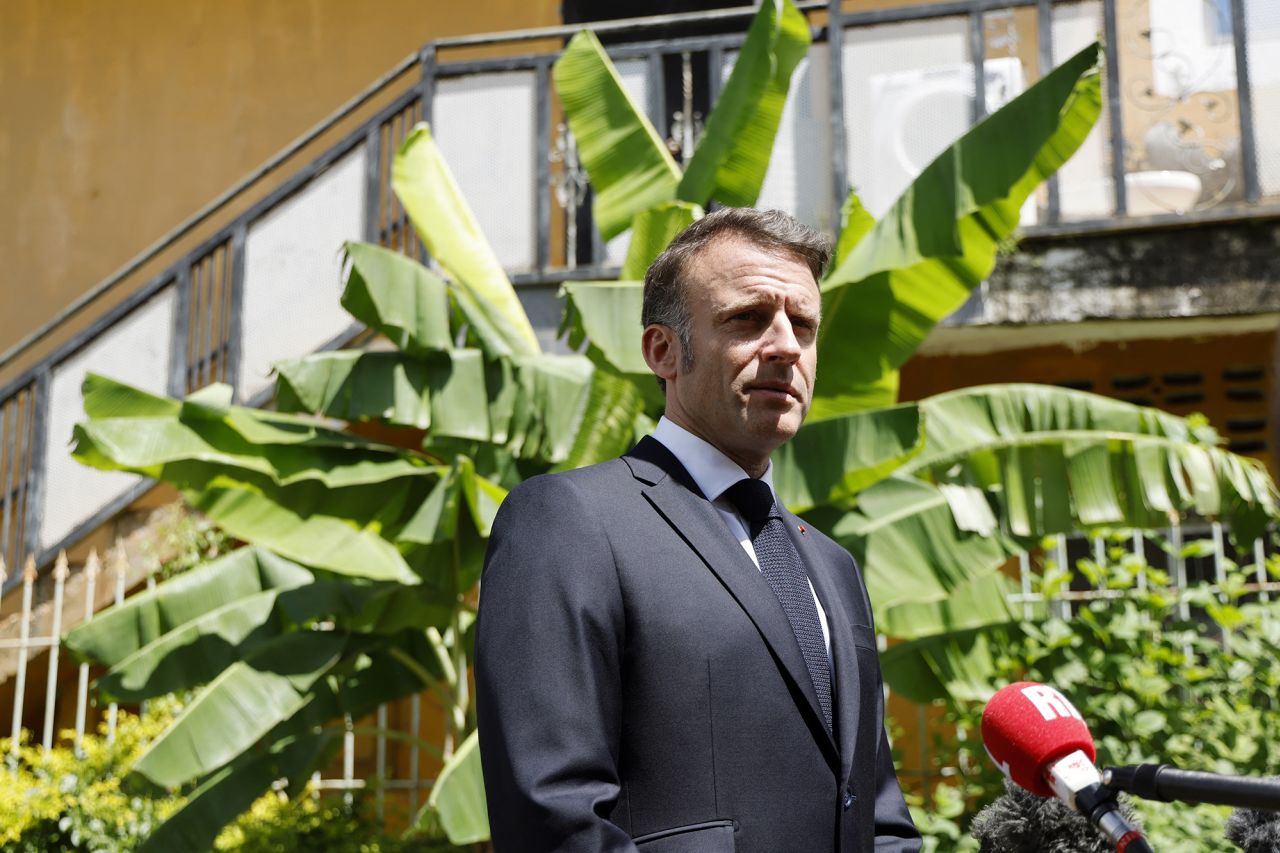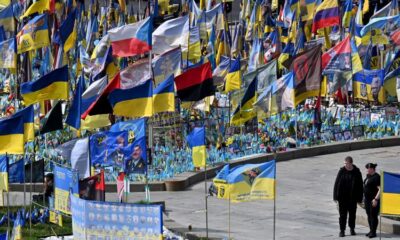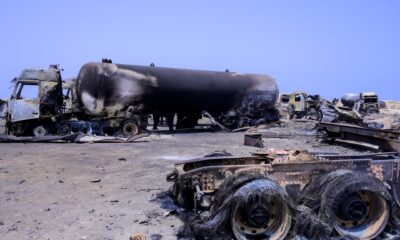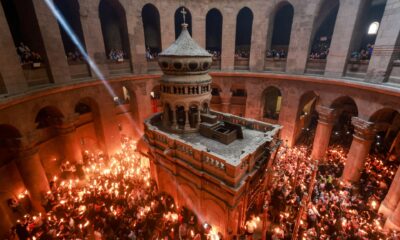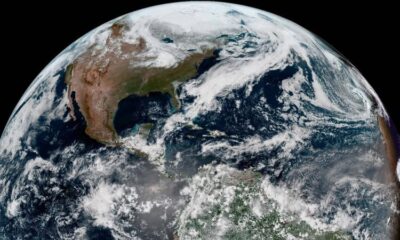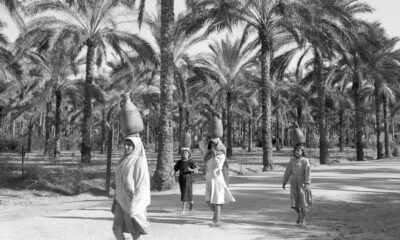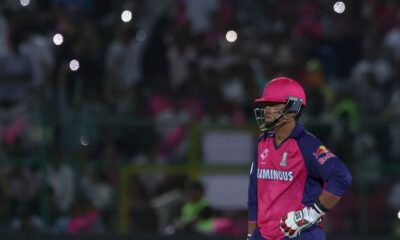Rome
CNN
—
Pope Francis, a voice for the poor who overcame fierce resistance to reshape the Catholic Church, died on Easter Monday at the age of 88, the Vatican announced.
The pope passed away the morning after the holiest day in the Christian year, when the world’s 1.3 billion Catholics celebrate the resurrection of Jesus Christ. Despite his poor health, Francis was seen a number of times in public at the Vatican during Holy Week, culminating in an Easter Sunday appearance where he delighted crowds at St. Peter’s Basilica in Rome.
The pope’s death was announced “with deep sorrow” by Cardinal Kevin Farrell, the Vatican camerlengo, who said Francis died at 7:35 a.m local time (1.35 a.m. ET). Until a new pope is chosen, Farrell acts as the head of the Vatican.
“With immense gratitude for his example as a true disciple of the Lord Jesus, we commend the soul of Pope Francis to the infinite merciful love of the Triune God,” the statement said.
Francis suffered a severe health crisis earlier this year and was hospitalized for five weeks with double pneumonia. His doctors said later that the pope was so critically ill the staff considered stopping his treatment so he could die.
But the pope recovered from the worst illness and was discharged last month and was convalescing at his residence at Casa Santa Marta at the Vatican. The Vatican said as recently as last week that his health was improving.
While he did not lead any major services during the holiday period, the pope continued to hold engagements up to Easter Sunday, when he met briefly with US Vice President JD Vance.
Francis gave the traditional Easter blessing from the balcony of St. Peter’s, although an aide read out the Urbi et Orbi on his behalf. He also rode the popemobile through the crowds gathered at the square, stopping several times to bless babies handed to him.
Vance said on X on Monday that he was happy to have seen the pope “though he was obviously very ill.”
“My heart goes out to the millions of Christians all over the world who loved him,” Vance said.
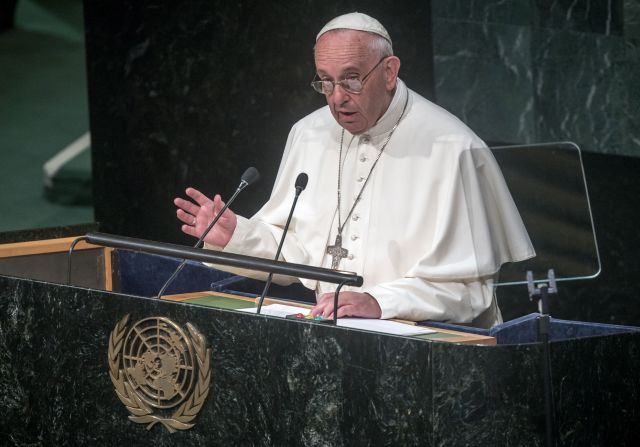
his speech, he urged world leaders to adopt concrete solutions to combat widespread poverty and environmental destruction.” class=”image__dam-img image__dam-img–loading” onload=’this.classList.remove(‘image__dam-img–loading’)’ onerror=”imageLoadError(this)” height=”2095″ width=”3000″ loading=’lazy’/>
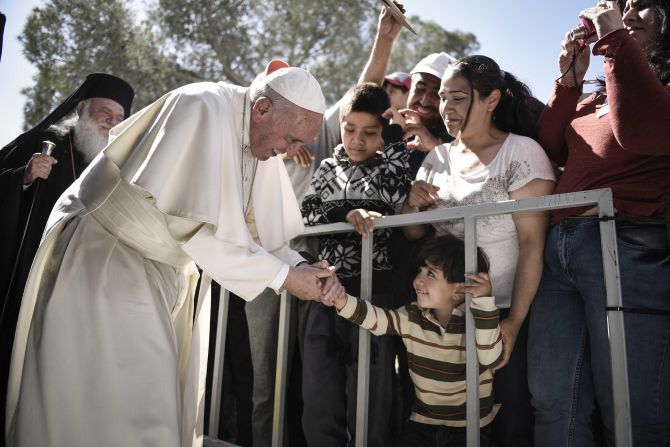
during a visit in which he showed solidarity with migrants fleeing war and poverty. ” class=”image__dam-img image__dam-img–loading” onload=’this.classList.remove(‘image__dam-img–loading’)’ onerror=”imageLoadError(this)” height=”1669″ width=”2500″ loading=’lazy’/>

was there to pay tribute to those who died in the Holocaust. ” class=”image__dam-img image__dam-img–loading” onload=’this.classList.remove(‘image__dam-img–loading’)’ onerror=”imageLoadError(this)” height=”1664″ width=”2500″ loading=’lazy’/>
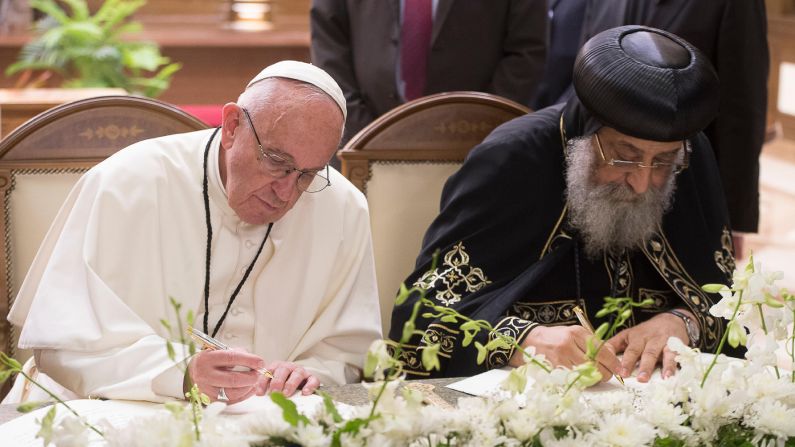
two-day trip to Egypt to forge Muslim-Christian brotherhood and show solidarity with the country’s persecuted Coptic Christian minority.” class=”image__dam-img image__dam-img–loading” onload=’this.classList.remove(‘image__dam-img–loading’)’ onerror=”imageLoadError(this)” height=”1569″ width=”2790″ loading=’lazy’/>

private audience at the Vatican in May 2017. Joining the President are his wife, Melania, and his daughter Ivanka.” class=”image__dam-img image__dam-img–loading” onload=’this.classList.remove(‘image__dam-img–loading’)’ onerror=”imageLoadError(this)” height=”2966″ width=”5272″ loading=’lazy’/>
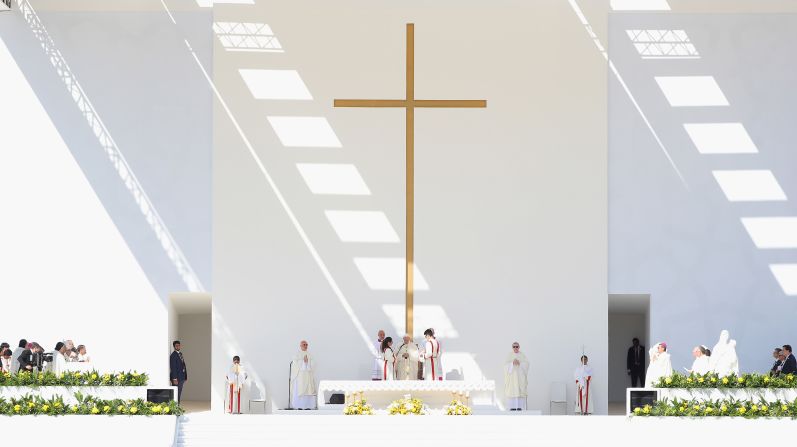
the first time a pope has visited an Arab Gulf state, and it was the first time a pope had celebrated Mass in the Arabian Peninsula, the birthplace of Islam.” class=”image__dam-img image__dam-img–loading” onload=’this.classList.remove(‘image__dam-img–loading’)’ onerror=”imageLoadError(this)” height=”1403″ width=”2500″ loading=’lazy’/>
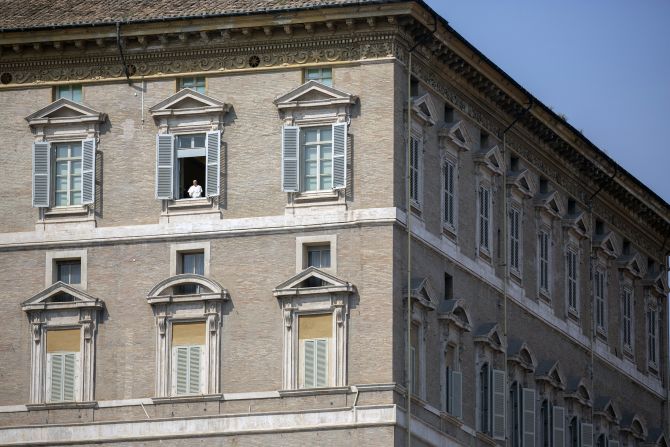
his weekly blessing from the window of his private library in March 2020. St. Peter’s Square is normally swarming with tens of thousands of visitors, but the Vatican was on lockdown because of the coronavirus pandemic.” class=”image__dam-img image__dam-img–loading” onload=’this.classList.remove(‘image__dam-img–loading’)’ onerror=”imageLoadError(this)” height=”1667″ width=”2500″ loading=’lazy’/>
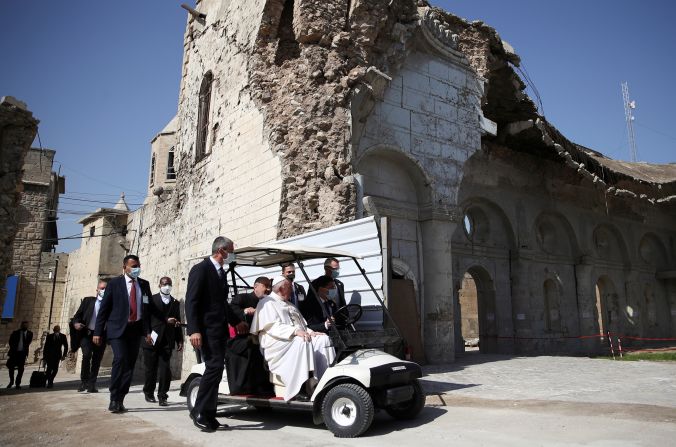
the first-ever papal visit to Iraq, and it was Francis’ first trip outside Italy since the start of the Covid-19 pandemic.” class=”image__dam-img image__dam-img–loading” onload=’this.classList.remove(‘image__dam-img–loading’)’ onerror=”imageLoadError(this)” height=”1654″ width=”2500″ loading=’lazy’/>
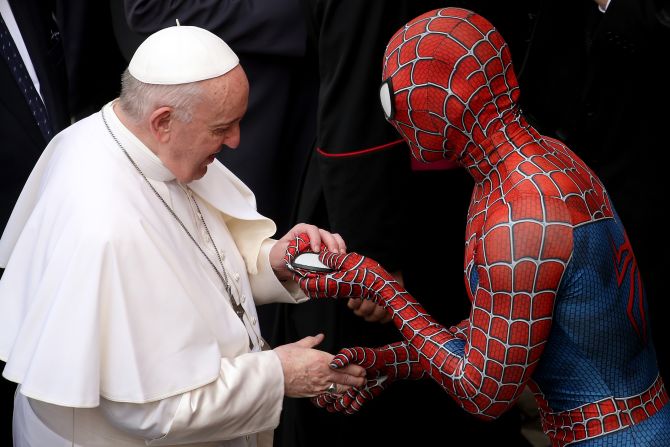
shakes hands with a man dressed as Spider-Man while visiting with people at the Vatican in June 2021. The masked man, who works with sick children in hospitals, also gave a Spider-Man mask to the Pope.” class=”image__dam-img image__dam-img–loading” onload=’this.classList.remove(‘image__dam-img–loading’)’ onerror=”imageLoadError(this)” height=”1667″ width=”2500″ loading=’lazy’/>
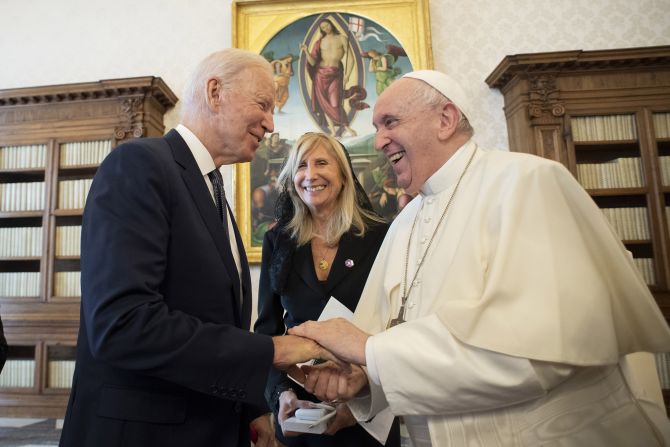
his trip to the Vatican in October 2021. Between them is Italian translator Elisabetta Savigni Ullmann. Challenge coins originated in the military, and this one included the insignia of a Delaware Army National Guard unit that Biden’s son Beau served in. Biden said during his visit that coins are given to “warriors and leaders” and that the pope is “the most significant warrior for peace I’ve ever met.” Biden, a devout lifelong Catholic, met with the Pope for 90 minutes and said he discussed “a lot of personal things” with the pontiff. It was the fourth meeting between Francis and Biden, but their first since Biden became President.” class=”image__dam-img image__dam-img–loading” onload=’this.classList.remove(‘image__dam-img–loading’)’ onerror=”imageLoadError(this)” height=”1667″ width=”2500″ loading=’lazy’/>
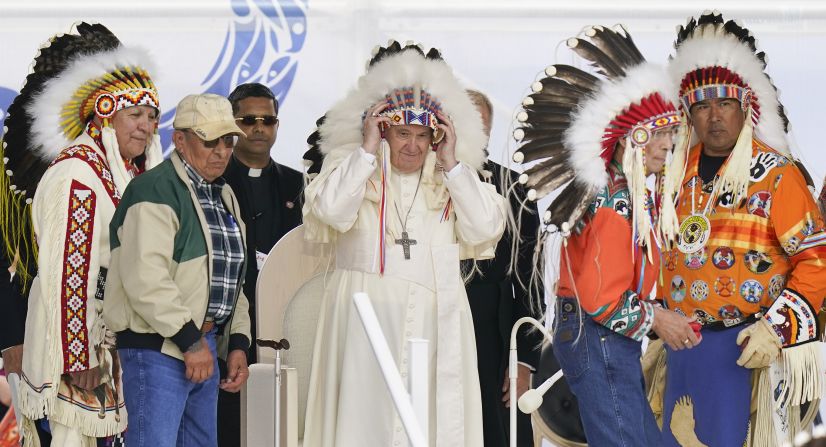
Francis spoke of his “sorrow, indignation and shame” over the Catholic Church’s role in the abuse of Canadian Indigenous children in residential schools. He apologized and promised a “serious investigation” into what happened.” class=”image__dam-img image__dam-img–loading” onload=’this.classList.remove(‘image__dam-img–loading’)’ onerror=”imageLoadError(this)” height=”1973″ width=”3646″ loading=’lazy’/>
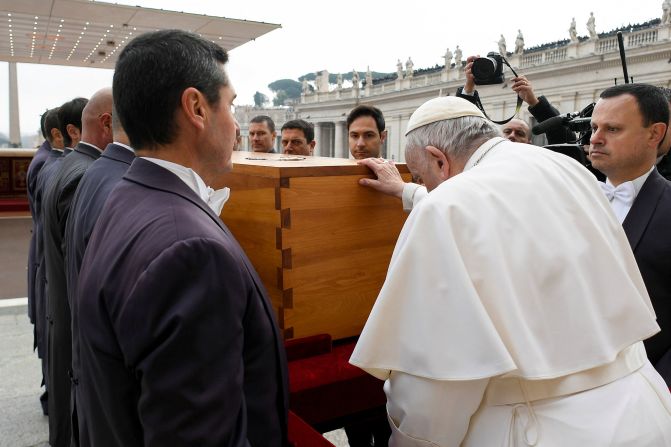
Benedict’s funeral was attended by tens of thousands at St. Peter’s Square.” class=”image__dam-img image__dam-img–loading” onload=’this.classList.remove(‘image__dam-img–loading’)’ onerror=”imageLoadError(this)” height=”2000″ width=”3000″ loading=’lazy’/>

Francis’ visit to the DRC — the first papal visit since 1985 — was part of a six-day trip that also included South Sudan. In those two countries, Catholics comprise about half of the population and the Church is a key stakeholder in health and education systems as well as in democracy-building efforts. ” class=”image__dam-img image__dam-img–loading” onload=’this.classList.remove(‘image__dam-img–loading’)’ onerror=”imageLoadError(this)” height=”1334″ width=”2000″ loading=’lazy’/>
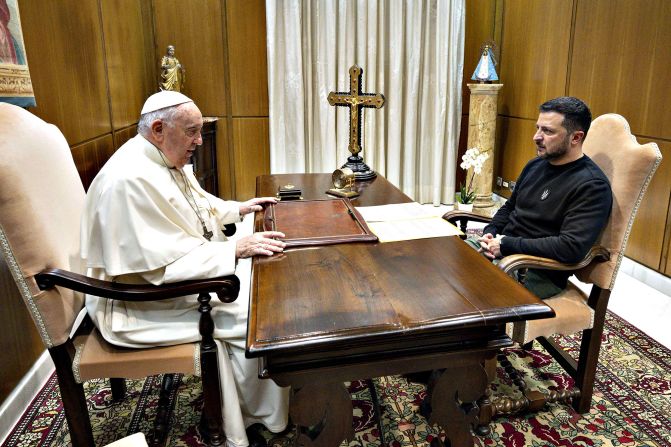
meets with Ukrainian President Volodymyr Zelensky at the Vatican in May 2023. It was the first face-to-face meeting between Zelensky and the Pope since Russia invaded Ukraine in February 2022. The Pope has been outspoken in his support for an end to the war.” class=”image__dam-img image__dam-img–loading” onload=’this.classList.remove(‘image__dam-img–loading’)’ onerror=”imageLoadError(this)” height=”1333″ width=”2000″ loading=’lazy’/>

He was on his way to a Rome hospital for abdominal surgery. The procedure was to repair a hernia that the Vatican said was causing “recurrent, painful and worsening” symptoms.” class=”image__dam-img image__dam-img–loading” onload=’this.classList.remove(‘image__dam-img–loading’)’ onerror=”imageLoadError(this)” height=”1333″ width=”2000″ loading=’lazy’/>

working session on artificial intelligence during the G7 summit near Bari, Italy, in June 2024. Francis, the first pope to participate in the summit, is determined to use the soft power of his office to try to ensure that the development of AI serves humanity and does not turn into a 21st-century Frankenstein’s monster.” class=”image__dam-img image__dam-img–loading” onload=’this.classList.remove(‘image__dam-img–loading’)’ onerror=”imageLoadError(this)” height=”1667″ width=”2500″ loading=’lazy’/>
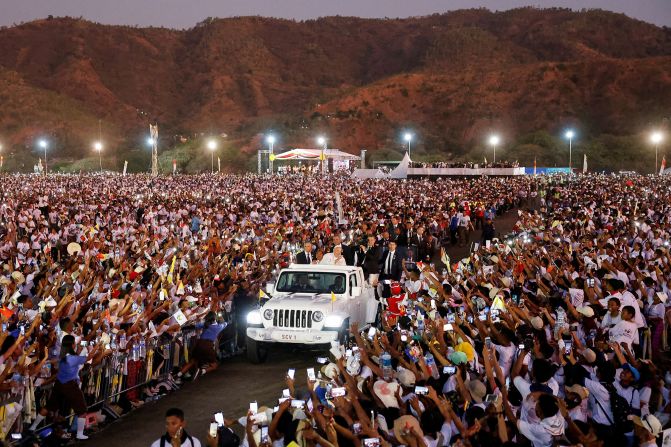
leading a Holy Mass at the Esplanade of Tasi Tolu in Dili, East Timor, on September 10, 2024.
” class=”image__dam-img image__dam-img–loading” onload=’this.classList.remove(‘image__dam-img–loading’)’ onerror=”imageLoadError(this)” height=”1333″ width=”2000″ loading=’lazy’/>
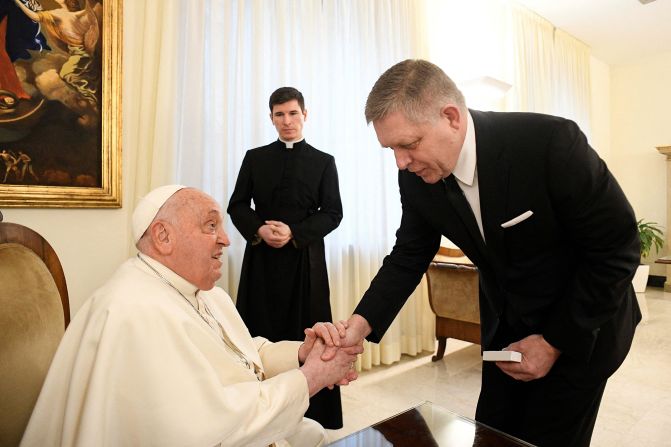
the Pope was admitted to a hospital in Rome. It was later announced that he was battling pneumonia in both of his lungs.” class=”image__dam-img image__dam-img–loading” onload=’this.classList.remove(‘image__dam-img–loading’)’ onerror=”imageLoadError(this)” height=”1333″ width=”2000″ loading=’lazy’/>

he was discharged from the Gemelli Hospital in Rome in March 2025. Though he looked frail and struggled to speak, he addressed the crowd outside the hospital, thanking them and acknowledging one woman in the crowd who was holding flowers. He also gave a blessing, though he appeared to have some difficulty raising his arms.” class=”image__dam-img image__dam-img–loading” onload=’this.classList.remove(‘image__dam-img–loading’)’ onerror=”imageLoadError(this)” height=”1242″ width=”2000″ loading=’lazy’/>
Pope Francis’ life in pictures
Condolences and tributes started to pour in shortly after the announcement was made. US President Donald Trump posted a brief statement on his Truth Social network, saying: “Rest in Peace Pope Francis! May God Bless him and all who loved him!”
Trump had a rocky relationship with Francis, whom he met at the Vatican in 2017. The pope’s tireless advocacy for migrants saw him sharply criticize Trump’s immigration deportation policies in the months before his death. Francis, whose pontificate was a counterweight to the rise of nationalist populism, often found himself under fire from powerful conservative Catholic forces in the US.
Italian Prime Minister Giorgia Meloni called the pope “a great man and a great pastor,” and said she “had the privilege of enjoying his friendship, his advice and his teachings, which never failed even in moments of trial and suffering.”
Meloni said the pope “asked the world, once again, for the courage to change direction, to follow a path that ‘does not destroy, but cultivates, repairs, protects,’” adding that she will “walk in this direction.”
Javier Milei, President of Francis’s home country Argentina, said that “having been able to know him in his kindness and wisdom was a true honor for me.”
Milei had clashed with the pope over his country’s economic policies. On Monday, he said their differences “seem minor today.”
Britain’s King Charles said the pope will be “remembered for his compassion, his concern for the unity of the Church and for his tireless commitment to the common causes of all people of faith, and to those of goodwill who work for the benefit of others.”
Charles and Queen Camilla paid a surprise visit to Pope Francis less than two weeks ago, during a state visit to Italy that coincided with the British royal couple’s 20th wedding anniversary.
Mourners began to arrive at St. Peter’s Square shortly after the announcement was made, with many seen praying, some of them in tears, as workers began removing the remaining Easter decorations. At noon local time, the bells of churches across the Italian capital began to toll slowly to mark the pontiff’s passing.
The pope’s death on Monday triggered the start of nine days of mourning. Francis’s body will be placed into a coffin on Monday evening, with a burial traditionally taking place between the fourth and sixth day after death.
The death of Francis, who became the first Latin American pontiff in 2013 and was one of the oldest popes in the church’s history, came weeks after he was discharged from a Rome hospital having battled a life-threatening case of pneumonia in both lungs.
His medical team said his condition had stabilized, allowing for him to continue his convalescence at his Casa Santa Marta residence back at the Vatican.
Two weeks after leaving hospital, he delighted the faithful by making a surprise appearance at St. Peter’s Square.
He has made a number of appearances since then, including spending 30 minutes at a prison in Rome on Thursday and a visit to St. Peter’s Basilica on Saturday evening.
His death will now open a debate about the future direction of the Catholic Church, with cardinals from across the globe expected to gather in Rome to mourn the pontiff and then elect his successor.
An outsider figure and the first non-European pontiff in nearly 1,300 years, Francis championed the poor, migrants and the environment, but divisions over same-sex relationships and how to tackle abuse scandals within the church persisted throughout his pontificate.
First Latin American and Jesuit to be elected
Francis, born Jorge Mario Bergoglio to Italian migrants in Buenos Aires in 1936, was the first Latin American and member of the Jesuit order to be elected pope in the church’s 2,000-year history. He was also the first pope to call himself Francis.
The Argentinian pontiff quickly gained a reputation as a modernizer, with an outward-facing approach which saw him speak out boldly on humanitarian crises, such as migration, war and climate change.
He sought to reform the church by tackling elitist mentalities among the clergy, demanding a compassionate approach to divorced and gay Catholics and insisting that the church welcome everyone.
He took a series of measures to address financial corruption in the Vatican, and to tackle the scourge of clerical sexual abuse, including laws to hold bishops accountable for coverups. Francis also sought an enlarged role for women working in the Vatican and authorized priests to offer blessings to same-sex couples.
He built bridges with the Muslim world, while seeking to play the role of peacemaker in the face of global conflicts, particularly in Ukraine and the Middle East.
His reforms saw him face unprecedented resistance from ultra-conservatives inside the church, although progressive Catholics felt he should have gone further in allowing the ordination of married men as priests, shifting official teaching on homosexuality and giving a greater space for women in ministry.
Despite taking a series of tough measures, Francis also failed to quell the scandal of child sexual abuse and other forms of abuse that have plagued the Catholic Church – a disgrace that he made his personal responsibility to end, but which continued to damage the institutional church in multiple countries throughout his papacy.
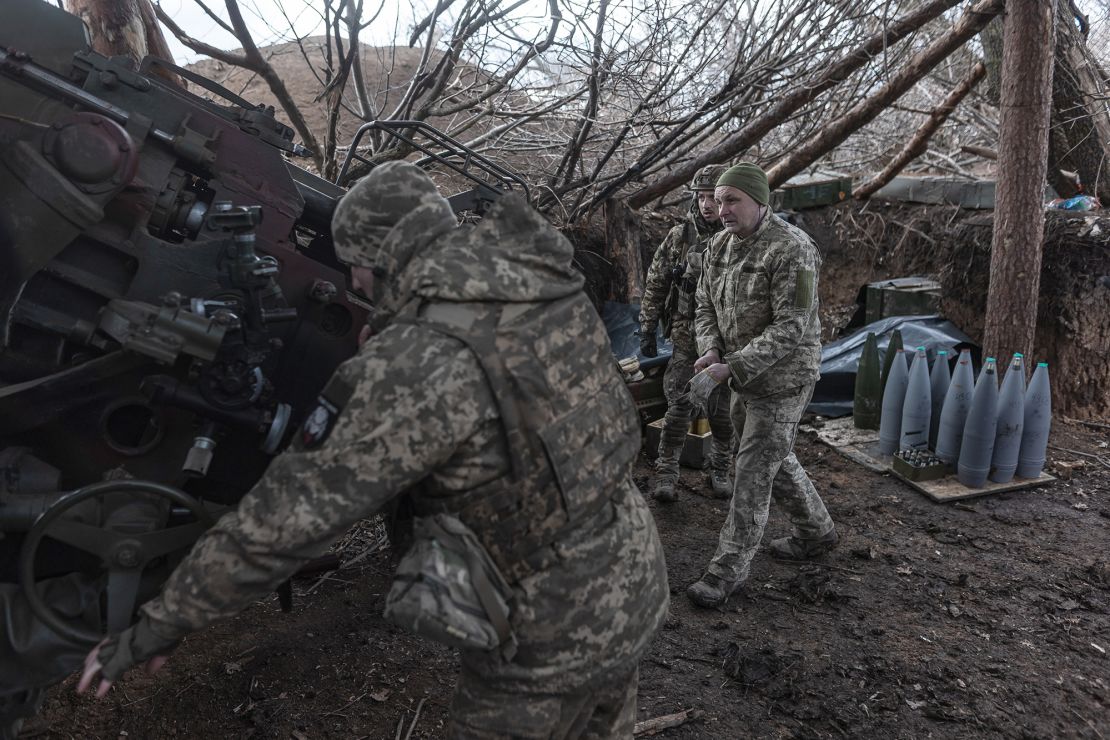


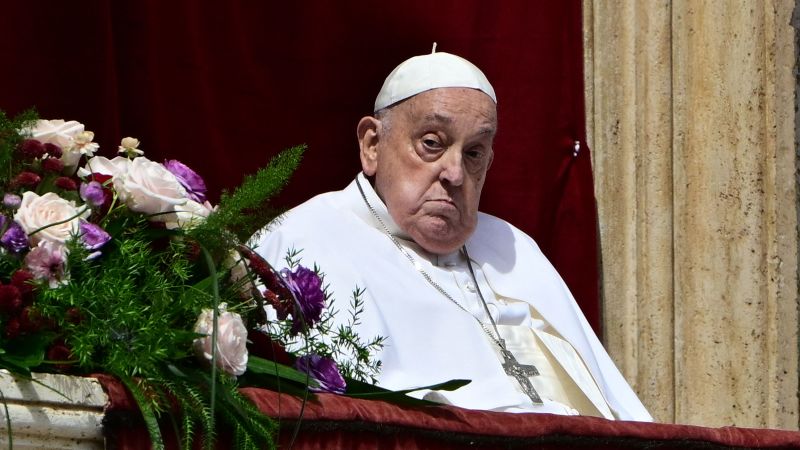

































 his speech, he urged world leaders to adopt concrete solutions to combat widespread poverty and environmental destruction.” class=”image__dam-img image__dam-img–loading” onload=’this.classList.remove(‘image__dam-img–loading’)’ onerror=”imageLoadError(this)” height=”2095″ width=”3000″ loading=’lazy’/>
his speech, he urged world leaders to adopt concrete solutions to combat widespread poverty and environmental destruction.” class=”image__dam-img image__dam-img–loading” onload=’this.classList.remove(‘image__dam-img–loading’)’ onerror=”imageLoadError(this)” height=”2095″ width=”3000″ loading=’lazy’/>





 during a visit in which he showed solidarity with migrants fleeing war and poverty. ” class=”image__dam-img image__dam-img–loading” onload=’this.classList.remove(‘image__dam-img–loading’)’ onerror=”imageLoadError(this)” height=”1669″ width=”2500″ loading=’lazy’/>
during a visit in which he showed solidarity with migrants fleeing war and poverty. ” class=”image__dam-img image__dam-img–loading” onload=’this.classList.remove(‘image__dam-img–loading’)’ onerror=”imageLoadError(this)” height=”1669″ width=”2500″ loading=’lazy’/>
 was there to pay tribute to those who died in the Holocaust. ” class=”image__dam-img image__dam-img–loading” onload=’this.classList.remove(‘image__dam-img–loading’)’ onerror=”imageLoadError(this)” height=”1664″ width=”2500″ loading=’lazy’/>
was there to pay tribute to those who died in the Holocaust. ” class=”image__dam-img image__dam-img–loading” onload=’this.classList.remove(‘image__dam-img–loading’)’ onerror=”imageLoadError(this)” height=”1664″ width=”2500″ loading=’lazy’/>




 two-day trip to Egypt to forge Muslim-Christian brotherhood and show solidarity with the country’s persecuted Coptic Christian minority.” class=”image__dam-img image__dam-img–loading” onload=’this.classList.remove(‘image__dam-img–loading’)’ onerror=”imageLoadError(this)” height=”1569″ width=”2790″ loading=’lazy’/>
two-day trip to Egypt to forge Muslim-Christian brotherhood and show solidarity with the country’s persecuted Coptic Christian minority.” class=”image__dam-img image__dam-img–loading” onload=’this.classList.remove(‘image__dam-img–loading’)’ onerror=”imageLoadError(this)” height=”1569″ width=”2790″ loading=’lazy’/>
 private audience at the Vatican in May 2017. Joining the President are his wife, Melania, and his daughter Ivanka.” class=”image__dam-img image__dam-img–loading” onload=’this.classList.remove(‘image__dam-img–loading’)’ onerror=”imageLoadError(this)” height=”2966″ width=”5272″ loading=’lazy’/>
private audience at the Vatican in May 2017. Joining the President are his wife, Melania, and his daughter Ivanka.” class=”image__dam-img image__dam-img–loading” onload=’this.classList.remove(‘image__dam-img–loading’)’ onerror=”imageLoadError(this)” height=”2966″ width=”5272″ loading=’lazy’/>







 the first time a pope has visited an Arab Gulf state, and it was the first time a pope had celebrated Mass in the Arabian Peninsula, the birthplace of Islam.” class=”image__dam-img image__dam-img–loading” onload=’this.classList.remove(‘image__dam-img–loading’)’ onerror=”imageLoadError(this)” height=”1403″ width=”2500″ loading=’lazy’/>
the first time a pope has visited an Arab Gulf state, and it was the first time a pope had celebrated Mass in the Arabian Peninsula, the birthplace of Islam.” class=”image__dam-img image__dam-img–loading” onload=’this.classList.remove(‘image__dam-img–loading’)’ onerror=”imageLoadError(this)” height=”1403″ width=”2500″ loading=’lazy’/>




 his weekly blessing from the window of his private library in March 2020. St. Peter’s Square is normally swarming with tens of thousands of visitors, but the Vatican was on lockdown because of the coronavirus pandemic.” class=”image__dam-img image__dam-img–loading” onload=’this.classList.remove(‘image__dam-img–loading’)’ onerror=”imageLoadError(this)” height=”1667″ width=”2500″ loading=’lazy’/>
his weekly blessing from the window of his private library in March 2020. St. Peter’s Square is normally swarming with tens of thousands of visitors, but the Vatican was on lockdown because of the coronavirus pandemic.” class=”image__dam-img image__dam-img–loading” onload=’this.classList.remove(‘image__dam-img–loading’)’ onerror=”imageLoadError(this)” height=”1667″ width=”2500″ loading=’lazy’/>

 the first-ever papal visit to Iraq, and it was Francis’ first trip outside Italy since the start of the Covid-19 pandemic.” class=”image__dam-img image__dam-img–loading” onload=’this.classList.remove(‘image__dam-img–loading’)’ onerror=”imageLoadError(this)” height=”1654″ width=”2500″ loading=’lazy’/>
the first-ever papal visit to Iraq, and it was Francis’ first trip outside Italy since the start of the Covid-19 pandemic.” class=”image__dam-img image__dam-img–loading” onload=’this.classList.remove(‘image__dam-img–loading’)’ onerror=”imageLoadError(this)” height=”1654″ width=”2500″ loading=’lazy’/>

 shakes hands with a man dressed as Spider-Man while visiting with people at the Vatican in June 2021. The masked man, who works with sick children in hospitals, also gave a Spider-Man mask to the Pope.” class=”image__dam-img image__dam-img–loading” onload=’this.classList.remove(‘image__dam-img–loading’)’ onerror=”imageLoadError(this)” height=”1667″ width=”2500″ loading=’lazy’/>
shakes hands with a man dressed as Spider-Man while visiting with people at the Vatican in June 2021. The masked man, who works with sick children in hospitals, also gave a Spider-Man mask to the Pope.” class=”image__dam-img image__dam-img–loading” onload=’this.classList.remove(‘image__dam-img–loading’)’ onerror=”imageLoadError(this)” height=”1667″ width=”2500″ loading=’lazy’/>

 his trip to the Vatican in October 2021. Between them is Italian translator Elisabetta Savigni Ullmann. Challenge coins originated in the military, and this one included the insignia of a Delaware Army National Guard unit that Biden’s son Beau served in. Biden said during his visit that coins are given to “warriors and leaders” and that the pope is “the most significant warrior for peace I’ve ever met.” Biden, a devout lifelong Catholic, met with the Pope for 90 minutes and said he discussed “a lot of personal things” with the pontiff. It was the fourth meeting between Francis and Biden, but their first since Biden became President.” class=”image__dam-img image__dam-img–loading” onload=’this.classList.remove(‘image__dam-img–loading’)’ onerror=”imageLoadError(this)” height=”1667″ width=”2500″ loading=’lazy’/>
his trip to the Vatican in October 2021. Between them is Italian translator Elisabetta Savigni Ullmann. Challenge coins originated in the military, and this one included the insignia of a Delaware Army National Guard unit that Biden’s son Beau served in. Biden said during his visit that coins are given to “warriors and leaders” and that the pope is “the most significant warrior for peace I’ve ever met.” Biden, a devout lifelong Catholic, met with the Pope for 90 minutes and said he discussed “a lot of personal things” with the pontiff. It was the fourth meeting between Francis and Biden, but their first since Biden became President.” class=”image__dam-img image__dam-img–loading” onload=’this.classList.remove(‘image__dam-img–loading’)’ onerror=”imageLoadError(this)” height=”1667″ width=”2500″ loading=’lazy’/>



 Francis spoke of his “sorrow, indignation and shame” over the Catholic Church’s role in the abuse of Canadian Indigenous children in residential schools. He apologized and promised a “serious investigation” into what happened.” class=”image__dam-img image__dam-img–loading” onload=’this.classList.remove(‘image__dam-img–loading’)’ onerror=”imageLoadError(this)” height=”1973″ width=”3646″ loading=’lazy’/>
Francis spoke of his “sorrow, indignation and shame” over the Catholic Church’s role in the abuse of Canadian Indigenous children in residential schools. He apologized and promised a “serious investigation” into what happened.” class=”image__dam-img image__dam-img–loading” onload=’this.classList.remove(‘image__dam-img–loading’)’ onerror=”imageLoadError(this)” height=”1973″ width=”3646″ loading=’lazy’/>

 Benedict’s funeral was attended by tens of thousands at St. Peter’s Square.” class=”image__dam-img image__dam-img–loading” onload=’this.classList.remove(‘image__dam-img–loading’)’ onerror=”imageLoadError(this)” height=”2000″ width=”3000″ loading=’lazy’/>
Benedict’s funeral was attended by tens of thousands at St. Peter’s Square.” class=”image__dam-img image__dam-img–loading” onload=’this.classList.remove(‘image__dam-img–loading’)’ onerror=”imageLoadError(this)” height=”2000″ width=”3000″ loading=’lazy’/>
 Francis’ visit to the DRC — the first papal visit since 1985 — was part of a six-day trip that also included South Sudan. In those two countries, Catholics comprise about half of the population and the Church is a key stakeholder in health and education systems as well as in democracy-building efforts. ” class=”image__dam-img image__dam-img–loading” onload=’this.classList.remove(‘image__dam-img–loading’)’ onerror=”imageLoadError(this)” height=”1334″ width=”2000″ loading=’lazy’/>
Francis’ visit to the DRC — the first papal visit since 1985 — was part of a six-day trip that also included South Sudan. In those two countries, Catholics comprise about half of the population and the Church is a key stakeholder in health and education systems as well as in democracy-building efforts. ” class=”image__dam-img image__dam-img–loading” onload=’this.classList.remove(‘image__dam-img–loading’)’ onerror=”imageLoadError(this)” height=”1334″ width=”2000″ loading=’lazy’/>



 meets with Ukrainian President Volodymyr Zelensky at the Vatican in May 2023. It was the first face-to-face meeting between Zelensky and the Pope since Russia invaded Ukraine in February 2022. The Pope has been outspoken in his support for an end to the war.” class=”image__dam-img image__dam-img–loading” onload=’this.classList.remove(‘image__dam-img–loading’)’ onerror=”imageLoadError(this)” height=”1333″ width=”2000″ loading=’lazy’/>
meets with Ukrainian President Volodymyr Zelensky at the Vatican in May 2023. It was the first face-to-face meeting between Zelensky and the Pope since Russia invaded Ukraine in February 2022. The Pope has been outspoken in his support for an end to the war.” class=”image__dam-img image__dam-img–loading” onload=’this.classList.remove(‘image__dam-img–loading’)’ onerror=”imageLoadError(this)” height=”1333″ width=”2000″ loading=’lazy’/>
 He was on his way to a Rome hospital for abdominal surgery. The procedure was to repair a hernia that the Vatican said was causing “recurrent, painful and worsening” symptoms.” class=”image__dam-img image__dam-img–loading” onload=’this.classList.remove(‘image__dam-img–loading’)’ onerror=”imageLoadError(this)” height=”1333″ width=”2000″ loading=’lazy’/>
He was on his way to a Rome hospital for abdominal surgery. The procedure was to repair a hernia that the Vatican said was causing “recurrent, painful and worsening” symptoms.” class=”image__dam-img image__dam-img–loading” onload=’this.classList.remove(‘image__dam-img–loading’)’ onerror=”imageLoadError(this)” height=”1333″ width=”2000″ loading=’lazy’/>






 working session on artificial intelligence during the G7 summit near Bari, Italy, in June 2024. Francis, the first pope to participate in the summit, is determined to use the soft power of his office to try to ensure that the development of AI serves humanity and does not turn into a 21st-century Frankenstein’s monster.” class=”image__dam-img image__dam-img–loading” onload=’this.classList.remove(‘image__dam-img–loading’)’ onerror=”imageLoadError(this)” height=”1667″ width=”2500″ loading=’lazy’/>
working session on artificial intelligence during the G7 summit near Bari, Italy, in June 2024. Francis, the first pope to participate in the summit, is determined to use the soft power of his office to try to ensure that the development of AI serves humanity and does not turn into a 21st-century Frankenstein’s monster.” class=”image__dam-img image__dam-img–loading” onload=’this.classList.remove(‘image__dam-img–loading’)’ onerror=”imageLoadError(this)” height=”1667″ width=”2500″ loading=’lazy’/>


 leading a Holy Mass at the Esplanade of Tasi Tolu in Dili, East Timor, on September 10, 2024.
leading a Holy Mass at the Esplanade of Tasi Tolu in Dili, East Timor, on September 10, 2024.


 the Pope was admitted to a hospital in Rome. It was later announced that he was battling pneumonia in both of his lungs.” class=”image__dam-img image__dam-img–loading” onload=’this.classList.remove(‘image__dam-img–loading’)’ onerror=”imageLoadError(this)” height=”1333″ width=”2000″ loading=’lazy’/>
the Pope was admitted to a hospital in Rome. It was later announced that he was battling pneumonia in both of his lungs.” class=”image__dam-img image__dam-img–loading” onload=’this.classList.remove(‘image__dam-img–loading’)’ onerror=”imageLoadError(this)” height=”1333″ width=”2000″ loading=’lazy’/>

 he was discharged from the Gemelli Hospital in Rome in March 2025. Though he looked frail and struggled to speak, he addressed the crowd outside the hospital, thanking them and acknowledging one woman in the crowd who was holding flowers. He also gave a blessing, though he appeared to have some difficulty raising his arms.” class=”image__dam-img image__dam-img–loading” onload=’this.classList.remove(‘image__dam-img–loading’)’ onerror=”imageLoadError(this)” height=”1242″ width=”2000″ loading=’lazy’/>
he was discharged from the Gemelli Hospital in Rome in March 2025. Though he looked frail and struggled to speak, he addressed the crowd outside the hospital, thanking them and acknowledging one woman in the crowd who was holding flowers. He also gave a blessing, though he appeared to have some difficulty raising his arms.” class=”image__dam-img image__dam-img–loading” onload=’this.classList.remove(‘image__dam-img–loading’)’ onerror=”imageLoadError(this)” height=”1242″ width=”2000″ loading=’lazy’/>



